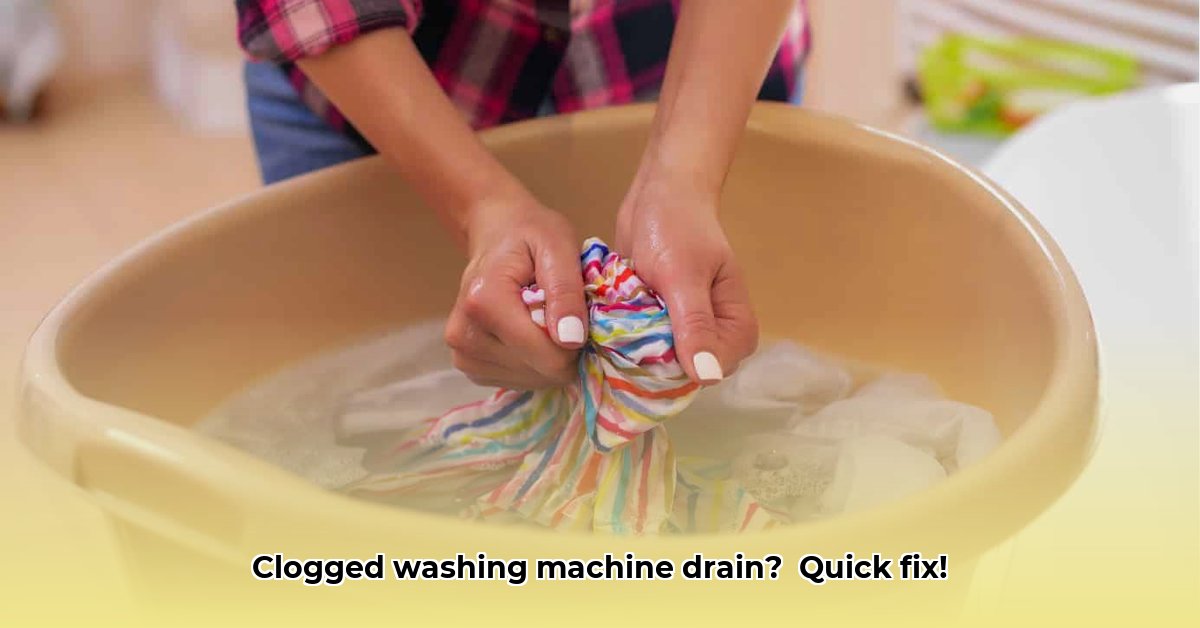Is your washing machine drain clogged? Don’t worry! You can often fix it yourself without calling a plumber. This guide provides step-by-step instructions for tackling everything from minor blockages to more stubborn clogs. Let’s get your laundry back on track and explore some effective washing machine troubleshooting techniques to save you time and money! For more in-depth troubleshooting, check out this helpful guide: washer drain issues.
Clear a Clogged Washing Machine Drain: Step-by-Step
A blocked washing machine drain is a common problem, and most of the time, it’s fixable without professional help. Let’s get that water flowing freely again!
1. Quick Checks: Identifying Easy Fixes
Before diving in with tools, start with a few simple checks. First, locate the washing machine’s drain filter, usually found at the back, often behind a small access panel. Open it up – you’re likely to find a collection of lint, hair, and other debris. This is often the main culprit! Remove the filter and clean it thoroughly using a toothbrush. Reinstall the clean filter, and often, that’s all it takes to restore proper drainage. This is an essential part of lint filter cleaning.
Next, check the drain hose. Look for kinks, bends, or any visible obstructions. A squashed or twisted hose can significantly restrict water flow and cause a backup. Gently straighten the hose, ensuring it’s not pinched or blocked. If you see a clog, try flushing it out with a strong stream of hot (not boiling) water. For stubborn clogs within the hose, a plumber’s snake (a flexible wire tool) can be useful. It allows you to directly address a hose blockage.
2. The Gentle Approach: Hot Water and Baking Soda & Vinegar
If the initial checks don’t resolve the issue, try a gentler approach. Carefully pour several gallons of very hot water (but not boiling!) directly down the drain. The heat helps to dissolve soap scum and loosen smaller clogs. This is a good first step for dissolving soap scum.
If hot water alone isn’t enough, use a classic cleaning combination: baking soda and vinegar. Pour approximately one cup of baking soda down the drain, followed by one cup of white vinegar. The mixture will fizz – this is the cleaning action at work! Allow it to sit for about 30 minutes to an hour, then flush thoroughly with hot water. This can be surprisingly effective for breaking down certain types of clogs and a time-tested method for natural drain cleaners.
3. The Heavy Duty Solution: Using a Drain Auger
If the gentle methods haven’t worked, it’s time to use a drain auger, or plumber’s snake. This flexible tool can reach deep into the drain to break up or remove stubborn clogs. Carefully insert the auger into the drain, rotating it as you feed it in. You’ll likely encounter resistance when it reaches the clog. Continue rotating to break up the blockage, and once you feel it loosen, slowly withdraw the auger. Be sure to clean the auger thoroughly after use to prevent transferring debris elsewhere. Using a plumber’s snake helps break up tough clogs.
4. Knowing When to Call a Plumber
There are times when even a determined DIY approach isn’t enough. If you’ve tried all the above steps and the drain is still clogged, or if you suspect a problem with the main drain line, it’s best to call a professional plumber. Plumbers have specialized tools and expertise to handle severe clogs or complex plumbing issues. While it might seem like an added cost, it’s better than risking further damage by attempting repairs beyond your capabilities. Understanding when to hire a professional plumber is crucial.
Troubleshooting Table: Common Scenarios and Solutions
| Problem | Possible Causes | Solutions |
|---|---|---|
| Slow Drainage | Partial clog, kinked hose, soap buildup | Clean the filter, straighten the hose, try hot water or baking soda/vinegar solution. |
| Complete Blockage | Severe clog, significant buildup in drainpipe | Use a drain auger, or call a plumber. |
| Water Backing Up | Clog in drain hose, standpipe, or main drain line | Check hose placement, use auger, or consult with a plumber. |
| Leaking Around the Machine | Loose hose connection, worn-out seals | Tighten the hose connection; if leaking persists, worn seals may need replacement – contact a plumber. |
Preventative Maintenance: Keeping Problems at Bay
The best approach to a clogged drain is to prevent it from happening in the first place! Regularly check and clean your washing machine’s drain filter. A simple step that can save you trouble later.
How to Unclog a Washing Machine Drain with a P-Trap Problem
Key Takeaways:
- A clogged washing machine drain often indicates an issue with the drain hose, the P-trap, or internal machine components.
- Start with simpler fixes and move towards more complex solutions.
- Regular maintenance and smart washing habits are key to prevention.
- Knowing when to seek professional help is as important as DIY skills.
A backed-up washing machine drain is inconvenient, but often resolvable. Before calling a plumber, let’s troubleshoot the issue together, focusing on washing machine drain safety.
1. Safety First! Disconnect Power
Always unplug your washing machine before any repairs to avoid electrical shock.
2. Examine the Drain Hose
Check for kinks, bends, or obstructions that could restrict water flow. If there are no clogs, proceed to the next step and address drain hose kinks promptly.
3. The P-Trap: A Common Culprit
The P-trap, the curved pipe under your sink, is designed to catch debris and is often the source of clogs. To check, focus on the P-trap function.
- Overflow Test: Run the washing machine for 30-60 seconds. If the water drains slowly or stops, the P-trap is likely the issue. If it drains very slowly, the blockage could be further down the drain line.
4. Clearing the P-Trap Clog: A Step-by-Step Guide
If the overflow test indicates a P-trap problem, follow these steps on how to unclog a washing machine drain with a p-trap issue:
- Place a bucket beneath the P-trap to catch spills.
- Loosen the slip nuts connecting the P-trap (pliers may be needed).
- Carefully remove the P-trap.
- Clean out any debris.
- Reassemble the P-trap securely.
- Run a test wash to ensure proper drainage.
5. Beyond the P-Trap: Investigating Other Causes
If the P-trap isn’t the cause, consider these alternatives.
- Drain Hose Connection: Ensure the drain hose isn’t clogged at the standpipe. A partial blockage here is common so it’s important to examine the drain hose connection.
- Baking Soda and Vinegar: Try the baking soda and vinegar solution for minor clogs. Use equal parts, let it fizz for 30 minutes, and flush with hot water.
6. When to Involve Professionals
DIY isn’t always enough. If you have persistent clogs, recurring issues, or damage to pipes or machine components, contact a qualified plumber and ensure professional plumbing assistance is sought out for more complex problems.
Washing Machine Drain Hose Problems: Prevention and Solutions
- Regularly inspect the drain hose for damage and clogs.
- Clear simple clogs with a plunger or drain snake.
- Tighten loose connections easily.
- Replace damaged hoses with the correct tools.
- Practice preventative maintenance.
- How to Stop Apps From Running in the Background to Boost Your - December 1, 2025
- How To Move Apps On Your Droid For Better Organization - November 30, 2025
- How to Move Apps on Android for Better Organization - November 29, 2025










